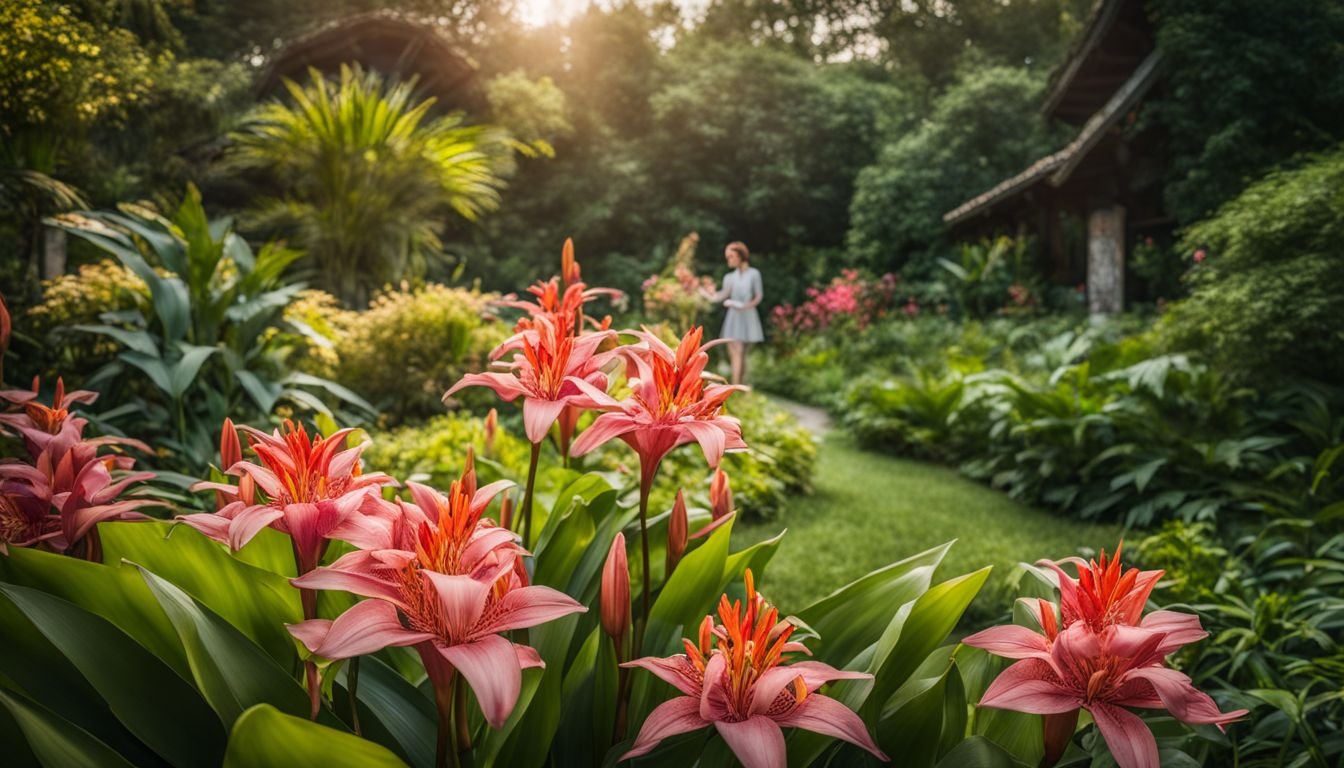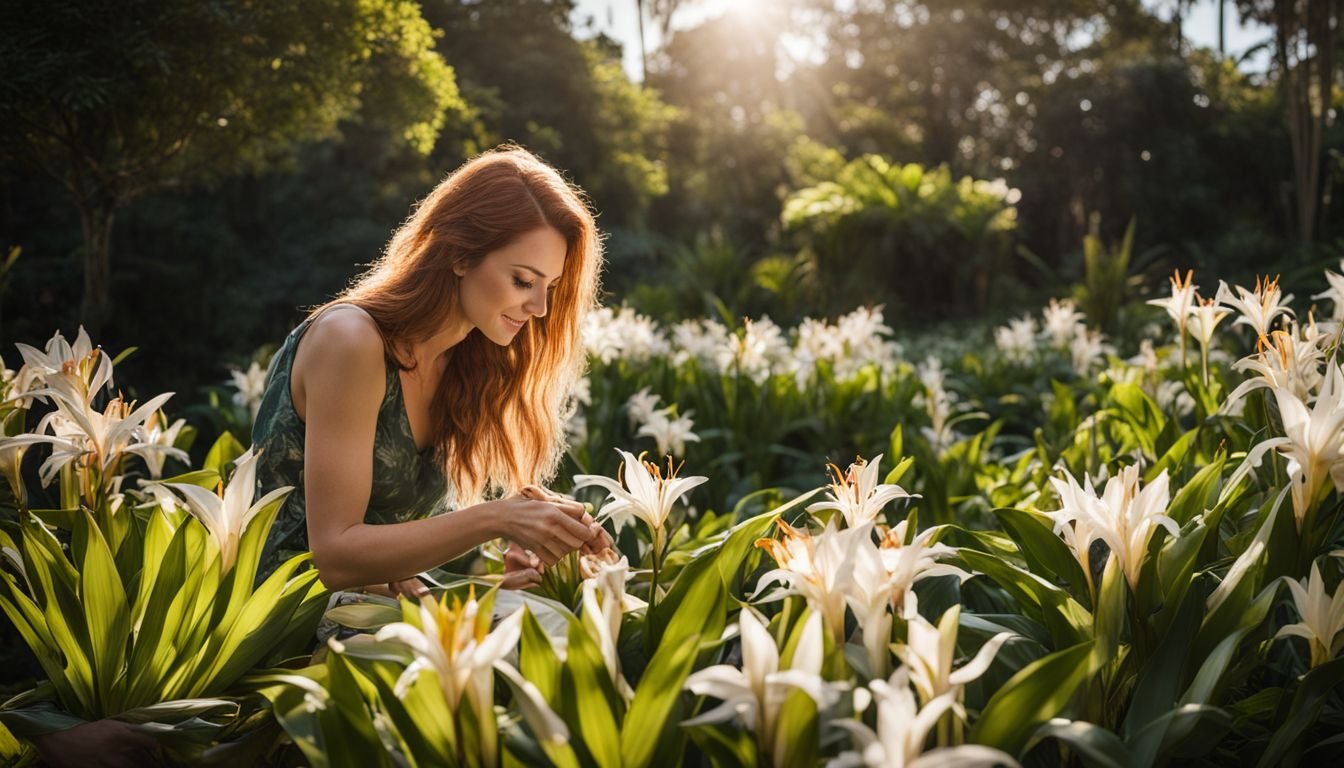Have you ever gazed out at your garden and felt it was just begging for a splash of tropical magic? You’re definitely not the only one. Loads of us Aussies are on the lookout to sprinkle a bit of vibrant colour and exotic fragrance into our outdoor spaces but often find ourselves scratching our heads about where to kick things off.
Enter the ginger lilies, especially types like the white ginger lily, known for their spellbinding scent and striking looks. We know what it’s like, trawling through options in search of that perfect plant that’ll take your garden from ho-hum to how amazing.
After doing a deep dive into what makes gardens tick, we reckon ginger lilies might just be the secret ingredient for turning your backyard into something truly head-turning with as little drama as possible.
These beauts aren’t just pretty faces; they’re tough as nails too, flourishing in everything from dappled shade to blazing sunshine. This yarn is chockers with advice on getting these spectacular blooms thriving down under – from picking the right spot climate-wise, prepping your soil just so, getting them in the ground properly, and keeping them looking ace with savvy care tricks like trimming back and fending off pests.
Let’s get stuck in and give your garden a dose of unforgettable!
Key Takeaways
- Ginger lilies, with their striking flowers and sweet scent, are ideal for adding a tropical touch to Australian gardens. They attract wildlife such as bees, butterflies, and birds while being low maintenance.
- These plants thrive in various climates across Australia because they can handle both full sun and partial shade. Growing them in well-drained soil enriched with organic matter ensures healthy growth.
- Planting ginger lilies after the last frost of spring sets them up for success. Watering correctly—keeping soil moist but not waterlogged—is key during hot periods.
- By splitting rhizomes or sowing seeds, gardeners can propagate ginger lilies effectively. This allows for expanding their presence in the garden over time.
- Proper care that includes regular watering, appropriate sunlight exposure, and fertilisation supports vibrant blooms throughout their flowering season from summer into autumn.
Understanding Ginger Lily

Ginger lilies, known for their striking flowers and sweet fragrance, hail from regions like India, Bhutan, and Nepal. These beautiful plants bloom in the warm months from summer into autumn, offering a range of colours that light up any garden.
They don’t just look good; they also attract bees, butterflies, and birds looking for nectar. We’ve seen how these plants can bring life to our gardens, not only with their visual appeal but as a hub for local wildlife.
Planting ginger lilies requires some know-how. They thrive best in conditions that mimic their natural habitat – think semi-shade or full sun areas with well-drained soil to keep their roots happy.
Water them regularly to maintain moist soil without making it waterlogged and add fertiliser during spring to encourage healthy growth. Come winter we divide them to manage their size and ensure they continue flourishing year after year.
This bit of effort keeps our gardens vibrant with the lush beauty of ginger lilies.
Benefits of Growing Ginger Lily in Australian Gardens

Having explored what Ginger Lily is, we now dive into why planting this ornamental plant in Australian gardens can be a game-changer. One major perk involves the attraction of wildlife; these plants become buzzing hubs for bees, butterflies, and nectar-loving birds.
This not only helps with pollination but also enriches your garden’s biodiversity. Imagine your outdoor space alive with colour and fluttering wings – it creates an enchanting atmosphere everyone loves.
Ginger Lilies are champions of adaptability too. They flourish under partial shade or semi-shade conditions, proving themselves to be both frost and drought-tolerant. Such resilience makes them perfectly suited for various Australian climates where weather patterns can drastically change.
From Summer through Autumn when they bloom, Ginger Lilies inject vibrant splashes of colour into gardens, making them visually stunning throughout most of the year.
Moreover, these perennial herbs demand minimal upkeep from us gardeners. Their low-maintenance nature means more joy and less work in keeping our gardens looking splendid. Whether you’re aiming for a cottage garden vibe or eye-catching floral displays by trees or wetlands, adding some Ginger Lily plants will undoubtedly elevate your garden’s aesthetic appeal without needing constant attention.
“Gardening adds years to your life and life to your years.”
Guide to Growing Ginger Lily
To grow Ginger Lily successfully, you’ll need to know the right spots, prepare your Earth well, and follow simple planting steps. This will ensure your garden shines with these stunning flowers.
Keep reading to learn how to make them thrive in your space.
https://www.youtube.com/watch?v=2vLPVD0L2IU
Climatic Zones
Ginger lilies are versatile flowers that thrive in various parts of our Australian gardens. They do well in semi-shade but can also handle both full sun and full shade. This makes them perfect for different weather conditions across Australia. Let’s explore the best climatic zones for growing ginger lilies and how to match them to the conditions in your garden.
| Hardiness Zones | Heat Zones | Climate Zones |
|---|---|---|
| 7 – 11 | 6 – 12 | 8, 9, 14, 15, 16, 17, 19, 20, 21, 22, 23, 24, H1, H2 |
Ginger lilies show great resilience, being frost and drought-tolerant once established. This means they can survive even when the weather gets tough. Our gardens in Australia fall into a wide range of climates. Knowing which zone your garden falls into can help greatly in growing healthy ginger lilies.
If your garden matches any of the climates in the table, ginger lilies could be a fantastic addition. They not only adapt well but also bring beauty and a tropical vibe to your space. Next, let’s look into preparing your soil for these wonderful plants.
Soil Preparation
Soil preparation sets the stage for your ginger lilies to thrive. With the right ground work, these flowers will light up your garden.
- Choose a well – drained spot in your garden. This ensures water doesn’t pool around the roots, leading to rot.
- Test the soil’s pH level. Ginger lilies prefer slightly acidic to neutral ground. Aim for a pH between 6 and 7.
- Add organic matter like aged compost or animal dung to enrich the soil. This nourishes your plants and improves drainage.
- Mix in slow – release fertilisers containing blood and bone meal to provide essential nutrients over time.
- Break up compacted earth with a digging fork, allowing roots to spread easily.
- Make sure the area is free of weeds and debris that could compete with your ginger lilies for resources.
- If dealing with clayey earth, consider raising beds or adding sand to improve its structure.
This groundwork supports robust growth, making your ginger lilies a standout feature in the Australian landscape.
Planting Process
After preparing the soil, our next step is planting Ginger Lilies. This process sets the foundation for a vibrant, healthy garden.
- Choose the right time – Plant in Spring after the last frost has disappeared. This gives your plants the best start.
- Select a sunny spot – Ginger Lilies thrive in sunlight but can also handle partial shade.
- Dig holes – Make them twice as wide as the root ball of your plants but just as deep.
- Incorporate nutrients – Before placing your plant in the hole, mix in some animal manure, blood and bone, or compost into the soil. These enrich the soil and give your plant a nutrient boost.
- Plant ginger lilies – Gently remove them from their containers and place them in the holes you prepared. Be careful not to disturb their roots too much.
- Backfill with soil – Once placed correctly, fill back the hole with soil and lightly press around each plant to eliminate air pockets.
- Water well – Give each new plant a good soaking to help settle them into their new home.
It’s essential we keep an eye on these newly planted beauties over their first few weeks, ensuring they get enough water and adjusting care as needed based on their growth and health signs.
Care for Ginger Lily Plants
Taking care of Ginger Lily plants in your garden needs a bit of know-how. They love getting full sunlight but also do well with some shade during the hottest part of the day. Make sure to give them enough water, especially when they’re first planted and trying to settle in.
Over time, you’ll want to cut back any dead parts to keep them looking neat and healthy.
Light Requirements
Ginger lilies are quite adaptable to different lighting conditions, thriving in areas from full sun to full shade. They show their best growth and flower production when they receive sunlight for part of the day but also enjoy some shelter during the hottest hours.
This makes them ideal for a variety of spots in Australian gardens. Whether you’ve got a sunny border or a partially shaded nook, these plants can fit right in.
For those growing White Ginger Lily (Hedychium coronarium), placing them where they’ll get both sun and partial shade works wonders, especially in organically rich soil that stays moist without getting waterlogged.
These beauties even do well near ponds or streams where their roots can access water easily. It’s all about finding that sweet spot between too much light and not enough—balance is key.
“In gardening, as in life, balance brings out the best blooms.”
Watering Guidelines
Watering ginger lilies right keeps them thriving. They love moisture but hate soggy roots. Follow these guidelines for best results:
- Keep the soil moist, not waterlogged. Use your finger to check soil moisture up to the second knuckle; if it feels dry, it’s time to water.
- During hot and dry periods, water more frequently to maintain soil moisture. This helps the plants cope with intense heat.
- Ensure good drainage in your garden bed or pot. Ginger lilies perform poorly in boggy conditions that can lead to root rot.
- Use mulch around the base of your plants. Mulch retains moisture in the soil and keeps roots cool, reducing water loss through evaporation.
- Water early in the morning or late in the afternoon to minimise evaporation losses during hot days.
- Adjust watering based on rainfall; reduce manual watering after heavy rainfalls to avoid overwatering.
- Apply a top dressing of fertiliser in spring, followed by watering, to help nutrients penetrate deeper into the soil and reach plant roots effectively.
Next, we’ll dive into how to propagate these stunning plants effectively.
Propagation Techniques
We all want our gardens to thrive with beautiful blooms. Learning the right way to spread ginger lilies ensures they grace your garden year after year.
- Splitting Rhizomes: Best done in winter, this method involves carefully digging up the plant. Use a sharp tool to separate the rhizomes, making sure each piece has at least one growth bud. Replant these segments in well-prepared soil to give them a fresh start.
- Sowing Seeds: For gardeners keen on seeing their plants bloom sooner, starting seeds indoors is a smart move. Fill small pots with a mix of soil and compost. Place the seeds on top and lightly cover them with more soil. Keep these moist and warm until seedlings appear, then move them outside when the weather warms up.
- Using Stem Cuttings: Though not as common for ginger lilies, stem cuttings can be an experimental approach for propagation. Cut a healthy stem segment and plant it in moist soil, ensuring some nodes are buried under the dirt. With some patience and care, roots will develop from these nodes.
- Layering Method: This technique might take longer but is quite simple and rewarding. Bend a low-hanging stem towards the ground and bury part of it while still attached to the parent plant. Over time, this section will grow its own roots and can be cut away from the main plant.
Keep your tools clean to avoid spreading diseases between plants, especially when cutting rhizomes or stems. Also, make sure your ginger lilies have enough space to grow; overcrowding can lead to poor health and fewer flowers. By following these steps, you’ll help ensure that your garden remains vibrant with stunning ginger lilies for years to come.
Conclusion
Gardening with Ginger Lilies adds vibrant colors and sweet scents to Australian gardens. These flowers love the local climate, from rainy parts to those that see more sun. Planting them right after winter ends gives them a strong start.
Care for these plants by watering often and giving them the right food in spring. Our guide helps make growing these beautiful blooms a fun project for any gardener.
FAQs
1. What is a Ginger Lilly and where does it grow best?
Ginger Lilly, also known as Hedychium gardnerianum or kahili ginger, thrives in rainforests and riparian areas. It’s a beautiful plant that loves the environment similar to its native montane forests.
2. Can Ginger Lilly become an invasive species in Australian gardens?
Yes, unfortunately, Ginger Lilly can turn into an environmental weed or invasive species if not managed properly, especially in agricultural and grassland areas.
3. How do I control unwanted Ginger Lilly plants in my garden?
To manage these plants and prevent them from spreading as pest plants, you can use herbicides like glyphosate carefully or physically remove them by digging up their roots.
4. Is it possible to grow Ginger Lilly in colder regions of Australia?
Ginger Lillies are winter-hardy to USDA zone 7b but are considered half-hardy elsewhere. In cooler regions, they might be grown as houseplants or require protection during cold months.
5. How should I care for my Ginger Lilly plant?
Regular pruning helps maintain your ginger lilly healthy; make sure to prune away old stems and decompose seed pods promptly. Also ensure they have enough space to flourish when planting or opt for transplanting if necessary.
6. Can I incorporate Ginger Lillies into different garden styles?
Absolutely! Whether you’re aiming for a lush cottage garden look or adding exotic touches around your property, gingers like the butterfly lily fit beautifully with various gardening styles due to their striking flowers and foliage.
